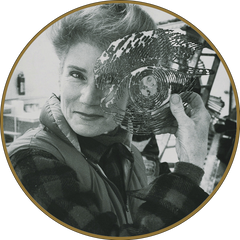Nancy Graves biography

Nancy Graves was an American artist of international fame, known for her prolific output and interdisciplinary work. Born in Pittsfield, Massachusetts, in 1939, she showed a strong interest in art, nature, and anthropology from a young age, encouraged by her father, an accountant at the Berkshire Museum. After graduating in English literature from Vassar College in 1961, Nancy Graves continued her studies at Yale University, where she earned a master's degree in painting in 1964. During her academic journey, she had the opportunity to attend courses with prominent artists such as Robert Mangold, Brice Marden, Chuck Close, and Richard Serra, to whom she was married from 1964 to 1970. This experience provided her with a solid artistic foundation and helped shape her distinctive style.
In 1969, at only 29 years old, Nancy Graves obtained a solo exhibition at the Whitney Museum of Art, becoming the youngest artist and the fifth woman to be selected for this prestigious recognition. From that moment on, her career took off, with exhibitions in museums and galleries worldwide, as well as commissions for large site-specific sculptures.
Nancy Graves's artistic production embraced a wide range of media, including sculpture, painting, drawing, watercolor, and printmaking. Since the 1960s, she experimented with unusual materials such as fur, jute, canvas, plaster, latex, wax, steel, fiberglass, and wood in her sculptures. Her early works, like life-size camels, were hand-modeled and carefully assembled, reflecting an interest in archaeology, anthropology, and natural science exhibitions.
After a period of intense dedication to sculpture, the artist returned to painting, creating detailed canvases that reproduced images taken from documentary naturalistic photographs, NASA satellite recordings, and lunar maps. Her pointillist painting style combined scientific accuracy with abstraction, exploring concepts of repetition, variation, and presentation of visual information.
In the 1980s, Nancy Graves expanded her artistic practice to include drawing, engraving, and the creation of large gestural watercolors. She also experimented with cast bronze, revitalizing the traditional lost-wax technique and creating unique sculptures with bright polychrome surfaces and distinctive patinas.
Nancy Graves continued to evolve artistically, exploring new materials and techniques until the end of her life. She incorporated hand-blown glass into her works and experimented with polioptic, a glass-like material that can be melted. Her artistic production addressed philosophical, perceptual, aesthetic, and technological issues, anticipating current themes such as data mining, multidisciplinarity, and research-based art.
The artist's career was cut short by her death in 1995, at the age of 54, due to cancer. However, her lasting impact on contemporary art and her pioneering spirit continue to inspire artists today. Her works are preserved in major museums around the world, a testament to her talent and enduring influence in the field of art.



